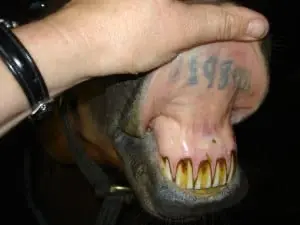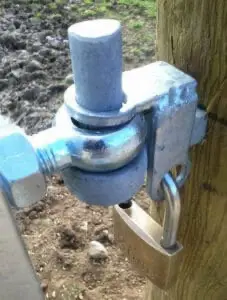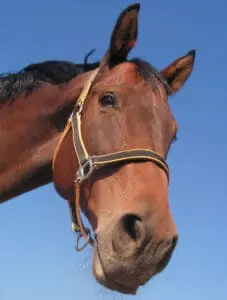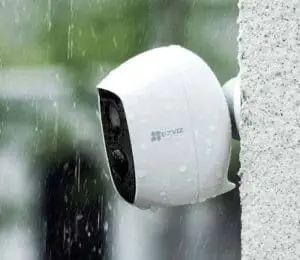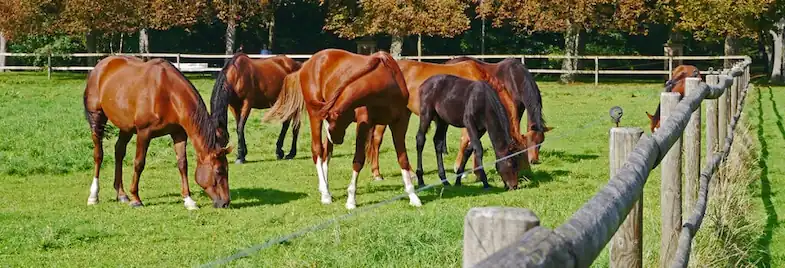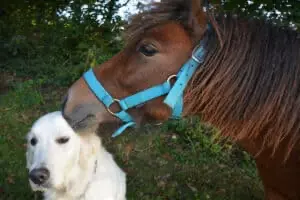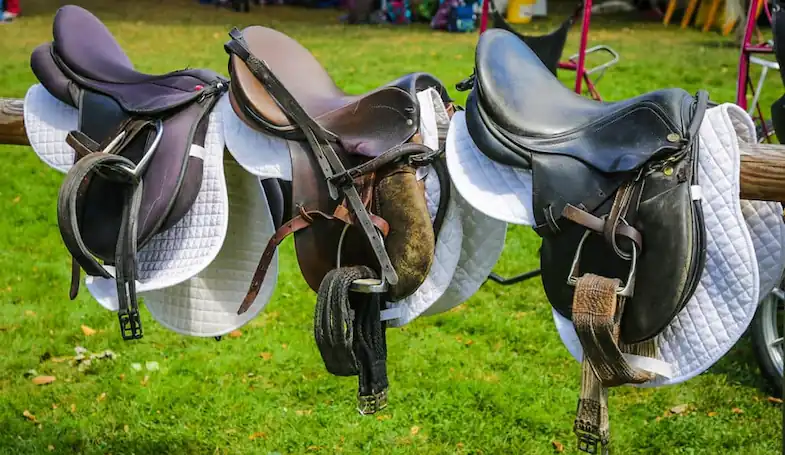Anybody who’s ever had a horse stolen, or knows somebody who has, will understand what a gut-wrenching experience it can be, it’s any owner’s worst nightmare. It’s a shocking fact that most horse thefts are planned and not the work of opportunists, but are in fact often carried out by two or more people working together to target a particular horse (or group of horses). The good news though is that, with a few simple steps, you can make your horse (and your equipment) far less desirable to any thief.
1) Permanently mark your horses
Having your horses permanently marked will not only work to deter a would-be thief but will also help to identify a stolen horse and reunite it with its rightful owner in the event that something does happen. The type of permanent marking you opt for will, to some extent, be determined by where you live (not all countries allow all types of marking) but also your personal preference.
- Branding – Often carried out with a hot iron, the horse is branded with a mark and number. The brand is often on the horse’s shoulder or rump but can be harder to see on grey or light-colored horses.
- Freeze marking – The opposite of branding, this method of permanent marking freezes a number on the horse’s skin and kills any pigment. When the fur grows back it doesn’t have any color so is easily identifiable. Like branding though this can be difficult to spot on light-colored horses.
- Lip tattoo – There is talk of lip tattoos being phased out but at the moment they are still a reliable way of marking a horse. A registration number is tattooed inside the horse’s upper lip and can easily be seen if you look. Unlike branding and freeze marking this will still be visible regardless of the horse’s coat color. The problem with this method though is that you need to lift the horse’s lip to see the mark.
- Hoof marking – Also known as hoof branding, this method is similar to branding in that a hot iron is used to brand a mark (typically the owner’s zip code) on the hooves. This is completely painless and can be clearly seen on all horse colors. The disadvantage of hoof marking though is that if the horse’s hove are muddy it can be difficult to spot, also the continuous growth of the hooves means that the process needs to be repeated regularly.
- Microchip – Some countries require all horses to be microchipped as a method of identification. While microchipping is invaluable in proving the ownership of a horse it doesn’t always work as a deterrent. This is because it’s difficult to establish if a horse is chipped just by looking at it, that said though you should display signs informing people that the horses have been microchipped.
Most owners will opt for a few different markings to ensure their horse is easy to identify in every situation.
2) Secure fences, gates, and barns
It goes without saying that you should make sure all of your gates are closed and that the fencing is secure without any gaps but there are a few other precautions that you should take too. If possible you should install a perimeter fence around the barn area, including the feed and tack rooms, this is even more important if your yard is close to the road. For fencing that is next to the road, you should consider a two-layer fence that will make it harder for anybody to get in from the road, the secondary outer fence should also act as an obstacle so could be made from barbed wire or dense brambles. If the law allows in your area an electric fence is an excellent security option, it will keep your horses safely inside the field while the thieves are outside and unable to get in.
When it comes to gates they should be fitted with anti-lift hinges if possible, this will make it impossible for the thieves to just lift the gate off of its hinges. You should ideally lock the gates too, but if you do make sure you still have quick access in the case of a fire.
You might not think that it’ll make any difference but you shouldn’t feed your horses near the road or by any gates. While this is obviously more convenient for you its also much more convenient for thieves too. This is because if a horse is hanging around the gate or road it’s easier for somebody to steal them, they won’t need to go far into the field to grab the horse, therefore, reducing the chances of them being spotted.
3) Don’t leave halters on
Be honest how often do you turn your horse out with his halter still on? It makes life so much easier if you can quickly grab hold of this when you’re bringing him in, the trouble with this though is it also makes it easier for a would-be thief to do the same. It’s important to get into the habit of removing the halter every time you turn him out, it’s also safer too because halters can get caught all too easily.
Once you’ve removed the halter don’t go and hang it from the fence (especially not with the lead line attached). If you’re going to do this you might as well just leave it on your horse! Instead, keep all halters locked away until they’re needed, this will make it harder for any thief to simply lead the horse away. After all, the harder you can make it for a thief the more likely they are to simply walk away and try another yard.
4) Use motion sensor lights
Some thefts do happen during the day but most will take place at night when it’s much darker and they’re less likely to be spotted which is why a few strategically place motion sensor lights will really help to reduce the chances of this happening. Don’t put them in every dark place but just areas where a thief could get in, areas such as by gates as well as barn entrances.
If you put the lights in places where the horses frequently go they’ll be setting them off a lot which will have a detrimental effect in the end because with the lights being activated all of the time people will stop paying attention to any activity.
5) Set up security cameras
Many yards will have some sort of security camera (or CCTV) set up to not only deter thieves but also to capture evidence if anything does happen. You might think that if you don’t have an Internet connection or a good phone signal at the yard then you won’t be able to use security cameras but this isn’t the case. While we’ve all heard about Nest and Arlo cameras that work over wifi there are also cameras that use a hard drive to record as well as those that can use a SIM card instead of wifi. Don’t worry if your yard doesn’t have an electrical supply don’t worry, you can also get solar-powered security cameras.
The main types of security cameras available are:
- NVR – Short for network video recorder, this system records footage direct to a recorder that can then be played back through a monitor or TV, it gives 24-hour monitoring – Amazon link.
- SD Card – Instead of recording to a recorder these systems will save the footage to an SD card that you can then connect to a computer to view it – Amazon link.
- Night Vision – If you don’t have security lighting at the yard you might want to consider cameras with built-in night vision. This will allow you to see what’s happening throughout the night – Amazon link.
- Internet Camera – Growing in popularity these cameras are quick and easy to install and can even send an alert to your cell – Amazon link.
- Solar-Powered Camera – If you don’t have an electrical supply then solar-powered cameras are perfect for you, they’ll store power during the day when the sun’s out and use it at night time to power the camera – Amazon link.
6) Randomly check horses
We all talk about how important it is that you keep to a routine with your horse and that certainly is true but having some variation in that routine will make it harder for thieves to strike when you’re not there. Some thieves will watch a yard for a while beforehand so they can get to know people’s routines, this will help them know when nobody will be there and how long they have before somebody turns up. If you vary when you go and check on your horse it will be much harder for a would-be thief to predict your movements.
7) Set up an owners watch program
If you have other horse owners (or even livestock owners) nearby then it’s a good idea to speak to them and organize a horse watch scheme where you all take it in turn to just check up on each other’s animals at random times. This will make it harder for thieves to predict when the yard will be empty of people.
8) Be vigilant
A lot of yards, especially those that are also riding centers, will have people wandering in and out all day but that doesn’t mean to say they’re all potential thieves. Instead, trust your instincts and make a note of the license plates of anybody that you think is acting strangely.
Sadly a lot of horse thefts are carried out by teams of people, one person will find a horse to target and then ‘mark’ the horse or yard to let somebody else know which horse to steal. There are a few ways they will leave a mark and its important to keep your eyes open for these signs and inform the police and local authorities (as well as any horse watch groups) if you notice any of them:
- Marking the horse – Some thieves will mark a horse by plaiting part of their mane, this is often a single plait in the mane that is harder to spot but will signal to the actual thief that this horse is the one to take. That doesn’t mean to say that if your horse’s mane has been plaited unexpectedly he’ll be stolen but you should still tell the police.
- Marking the yard – A number of recent horse thefts have had signs that the yard has been marked by ash being ’ spilled’ by the gate or some sort of mark, such as a drop of paint or a broken branch, being made on the road. A few yards have also had a bag being tied to the gate before a number of horses where stolen. While its almost impossible to prove there is a connection between this and a theft it is, in my opinion, much better to be safe before rather than wise after.
9) Display prominent signs
The right signs, in the right place, can be much more of a deterrent than you might realize because they’ll let thieves know that the area is monitored and that the horses are regularly checked rather than just left unattended for days on end. You don’t need to have expensive, all singing all dancing signs, simple ones alerting people to the fact that there are cameras and/or alarms or that the horses are marked or microchipped will all work. Even a no trespassing sign will act as a deterrent with many thieves not wanting to take a chance.
10) Keep up-to-date records
All owners should have an ‘ownership’ file that contains everything you need to prove you own the horse as well as any registration documents and health/vaccine records. If your horse has a passport too then this should also be kept in the file. It’s also a good idea to keep current photographs of your horse in the file too, these should include the front, rear, both sides, a close-up, and any identifying marks or characteristics your horse has. This will help to identify your horse if anything should happen and you can also use the photographs for fliers or adverts if he is stolen. While not completely necessary I also like to have a full written description of every horse too.
We’ve put together a handy horse record kit that you can download for FREE here.
11) Additional security
Even if it’s not a trained guard dog having a dog around the yard is an amazing deterrent because most thieves hate dealing with them and will instead try another yard without horses. The reason that dogs are such a good hindrance to would-be thieves is that they can be so vocal and will draw attention to any unusual activity.
If you do decide to have a dog around the yard then you’ll also need to consider the welfare of the dog too and how they’ll interact with horses, not all dogs get on with horses, and likewise, some horses will feel stressed with a dog around the yard.
12) Make sure your horse is insured
While insurance of course won’t prevent your horse from being stolen (nor will it act as any type of deterrent) but it will help if the worst does happen. Many insurance policies will help you search for your horse if it is stolen (they will also do this if your horse strays for any reason, whether it’s due to a fire, hurricane, earthquake, or for another reason). How they do this will vary from policy to policy but in general, they’ll pay towards the cost of advertising to try and recover your horse (normally fliers, online adverts, etc). Some policies will also alert the relevant authorities and organizations.
13) Secure expensive equipment
As well as making sure your horse is secure and safe from thieves you should also do the same for your tack, many saddles are very expensive yet a lot of people don’t consider protecting them. If the cost of any items is really high it’s a good idea to insure them too but either way, you should security mark any high-value tack. You can easily (and cheaply) have your phone number and/or zip code etched onto the underside of your saddles, although this won’t deter any thieves it will make your tack easier to recover if it is stolen.
You should also keep your tack securely locked (and ideally alarmed) in an unmarked tack room. I say unmarked because otherwise, you might as well have a neon sign on the door telling thieves where all of your expensive tack is kept. Don’t forget that any thief will want to be in and out as quickly as possible and if they don’t know where any high priced items are kept they’ll be more likely to just leave, rather than try multiple locked doors.
14) Protecting your trailer
Trailers are not only stolen on their own but they can (and often are) used to steel the horses at the yard too which is why you want to hide your trailer as much as possible, don’t leave it parked in plain sight near the road if you can help it. Many trailers, especially gooseneck ones, can easily be padlocked so make sure you invest in a good quality commercial lock.
It’s also important to make a note of any serial numbers or VIN (vehicle identification number), if your trailer is stolen the police will need to know them but they could also help you to get the trailer back if it is stolen.
Conclusion
You might think that horse theft is a common and widespread crime but despite the scare stories we’ve all heard it’s thankfully not as common as you might think. It’s estimated that around 60,000 horses were stolen in the US last year but when you consider the country has over 9 million horses it’s not as common as it first seems. That’s not to say it’s any less devastating for the people whose horses are stolen though, I’m just saying that if you take the right precautions you’ll be greatly reducing your risk, after all, there’s no need to be scared if you’re prepared.
Some horses are stolen for resale so if you travel to shows or events a lot it’s important to be on guard at these events. You should also speak to the organizers about the security measures they have in place and if necessary take extra precautions yourself.
Further reading
- Keeping a horse at home
- Preventing loneliness
- Where should I keep my horse?
- Too stable or not at night?
- Is leasing better than owning?
- Preparing for a hurricane
- How to sell your horse
- Life hacks for owners
- Protecting horses from sunburn
- Do horses need supplements?
I hope you found this article helpful. If you did I’d be grateful if you could share it please as it would really help me.
Recommended products
Over the years I have tried hundreds of different horsey products, from various blankets and halters to different treats. Some I’ve loved, others I’ve hated but I thought I’d share with you my top all-time favorite products, the ones I never leave the yard without. I’ve included links to the products (which are in no particular order) that I really think are great.
- Horse Knots by Reference Ready – If you’re like me and enjoy pocket reference guides then you’ll love this knot tying guide. These handy cards can easily fit in your pocket or attach to the saddle for quick reference. They’re waterproof, durable and are color coded to make them easy to follow.
- Mane ’n Tail Detangler – Even if you never show your horse you’ll need to detangle his tail from time to time (and possibly his mane too) which is always a challenging chore! I’ve found that if I run a little bit of detangler through my horse’s tails every few days it stops them from getting matted up and makes combing them easy, even if they’re coated in mud. I don’t know if I should admit to this or not but it also works wonders on my hair.
- TAKEKIT Pro clippers – Over the years I’ve tried a lot of different clippers and while some were obviously better than others I found these to be by far the best. They are heavier than a lot of other clippers but for me, that’s a good thing, it makes them feel more sturdy and hardwearing. On top of that they have a range of speeds so are just as good for clipping your horse’s back as they are his face. I also like the fact that they come in a handy carry case but that’s not for everybody. The company that makes them is super good and incredibly helpful too, a real bonus these days. The only thing I wasn’t keen on was the fact that it doesn’t come with any oil, but that’s not a major problem as it’s not difficult to buy lubricant.
- Shire’s ball feeder – There are so many boredom buster toys out there but I like to use these every day, regardless of whether or not my horses are bored. I find that it helps to encourage my horses to problem solve by rewarding them with treats (or pieces of fruit) but it also mimics their natural grazing behavior which helps to keep them calm and de-stressed.
- Horse safe mirror – This is a strange one that many people are surprised about but I like to put horse safe mirrors in the trailers as well as in the quarantine stalls. It helps to prevent the feeling of isolation by giving the impression of other horses being around. Being herd animals horses can get extremely stressed when they feel that they’re on their own but with these stick-on mirrors, they believe that at least one other horse is with them.
- Rectal thermometer – I know this isn’t glamourous at all but it’s vital for your horse’s well-being to be able to check their temperature and a rectal thermometer is the easiest way of doing this which is why I’ve added it to the list.
Shopping lists
I’ve also put together a few shopping lists of essential items that I’ve found helpful over the years. I’ve broken the lists down into different categories rather than put everything in one massive list 😉

